I am going to take the weekend off from the computer because I have a Mountain Of Things to Do away from it. Next week, I'll have a series of posts about quick Japanese pickles, or sokuseki zuke. Sokuseki zuke pickles are the busy cook's alternative to 'real' pickles like nukazuke (rice brain pickles), of the kind that require nursing a pickling bed, long resting periods, and such complicated procedures. The word sokuseki means instant, and these pickles are usually ready to eat in a short period, anywhere from overnight to about an hour.
Filed under:
japanese preserves and pickles vegetables
Submitted by maki on 14 March, 2007 - 14:51
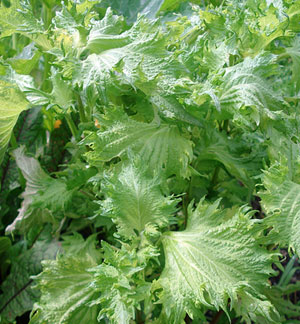
I am finally getting around to sowing some seeds for the vegetable garden. I really should have sown some things earlier, but I figure it's not too late yet.
If you are planning a vegetable garden, or even a few pots on your windowsill, and want to introduce some Japanese flavors, here's a list of some herbs and vegetables to consider growing, in order of importance and ease of growing in a temperate climate. (That's one with real winters...at least, before global warming.) The ones marked with an *asterisk can be grown in pots. A couple of my favorite seed sources are listed at the bottom.
Type:
feature Filed under:
japanese vegetables shopping gardening herbs
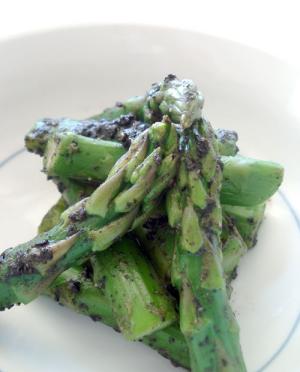
We're starting to see asparagus at reasonable prices again in the stores, which I'm really happy about. The ones available now come from California and Mexico, so they aren't very food-miles-correct, but I still can't resist buying a bunch or two. In a few weeks we'll start seeing asparagus from a a bit closer places like Spain and France, not to mention fat white asparagus from Germany.
This is aspagarus with a ground sesame sauce, which would be called aemono (as explained in the broccoli ae recipe) if made with white sesame seeds, but since this version is made with black sesame seeds it's called gomayogoshi, or "dirtied with sesame". I don't think it looks dirty - I really like the contrast of the bright green asparagus with the black sesame sauce. You can, of course, use regular white (brown) sesame seeds instead, in which case it would be called asparagasu no goma ae. The sweet nutty sauce compliments the asparagus quite well.
I've included step by step instructions for grinding sesame seeds in a suribachi. You can grind up the sesame seeds in a plain mortar and pestle instead. You may be able to buy pre-ground sesame (surigoma), though that isn't nearly as fragrant as freshly ground sesame.
It makes a great side dish, as well as being great for your bento box.
Filed under:
japanese lighter vegetables vegetarian bento vegan gluten-free

When I wrote about essential Japanese cooking equipment a while back, I forgot to mention one item that I use quite often, a suribachi. A suribachi is a sturdy ceramic bowl that's used with a grinding stick called a surikogi like a mortar and pestle. While I'm a big fan of handy electric equipment like food processors for many tasks, sometimes the results you get by doing things by hand are well worth the elbow grease needed.
Filed under:
equipment japanese
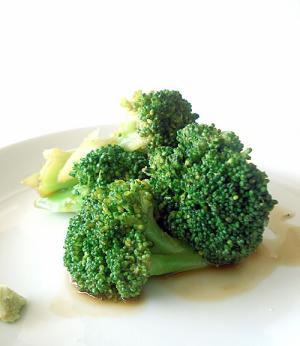
All hail the mighty broccoli. While it's always available in the produce section, it's one of the few fresh vegetables that haven't been shipped halfway around the world to reach people who live in many parts of the northern hemisphere during the colder months. In the spring we even get very locally grown broccoli and its relatives like romanesco.
Broccoli can be rather boring if it's just served steamed, boiled or, god forbid , raw. (I'm sorry, I don't really get raw broccoli. Raw cauliflower yes, but not raw broccoli.) A way to perk up broccoli without relying on those yummy yet caloric additions like mayonnaise, cheese sauce or garlic-and-olive-oil, is to make aemono or ohitashi with them. Ohitashi is basically vegetables that have been steamed or blanched/boiled served with a sauce that contains soy sauce, often but not always a little dashi stock, and sometimes a bit of sake or mirin and sugar. Aemono uses a similar sauce, with added ingredients like ground up sesame seeds. In this recipe, the sauce contains wasabi, so it's aemono.
As long as you have all the ingredients on hand it's very quick to make, and very tasty. The sinus-clearing qualities of the wasabi are softened by the other ingredients in the sauce, while still giving the broccoli a nice, bright flavor.
It makes a great side dish as part of a Japanese meal, or even a salad. It's also a very nice bento item (you may want to contain the sauce in a paper cup or its own container).
Filed under:
japanese lighter vegetables vegetarian quickcook bento vegan under10 gluten-free
On the New York Tiimes Diners Journal blog, which is no longer just written by Frank Bruni, Julia Moskin writes about a Japanese food symposium held at the Japan Society. She reports that "Iron Chef" Masaharu Morimoto called the Japanese government's plans to certify "authentic" Japanese restaurants "nonsense". Now, fans of the original (and best) Japanese version of Iron Chef may remember Chef Morimoto's ongoing "battles" with chefs who cooked "authentic Japanese"; while a lot of it seemed like fake drama for the cameras, perhaps there was some truth in it after all. He did make some pretty outrageous, not to mention downright odd, things under the guise of "nouvelle Japanese" on occasion, which seemed to get some more "authentic" Japanese chefs rather upset. If we assume that the standards of 'authenticity' might be dictated by such chefs, people like Chef Morimoto, not to mention Nobu Matsuhisa, may not pass muster. Not to say they don't produce good, even great, food. (Though I must admit I'm not a big Nobu fan. To be fair I've only been there once, years ago, and had a 'server problem' which clouded things. And I've never been to a Morimoto restaurant.)
Filed under:
essays japanese restaurants
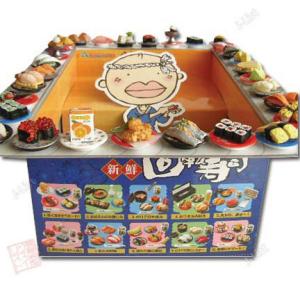
I normally stay away from kaiten-zushi (kaiten sushi) or conveyor-belt sushi restaurants, since the quality can be iffy. But I could really go for this adorable miniature kaiten-zushi miniature set! (I'm not sure why the itamae-san (sushi chef) has Angelina Jolie lips though....) It's a new themed set from Re-Ment (US site) (Japanese site), a Japanese company that makes amazingly detailed die-cast miniatures called Puchi Petites, mostly of food and related items like cooking equipment, but of other things too. The miniatures started out as omake, or free gifts that came with the purchase of candy, but the miniatures have become so popular that the candy, while it's still included, is now a mere afterthought.
Filed under:
japanese sushi offbeat cute
Recently there was an article in the Washington Post about some attempts by the Japanese government to set up some kind of authenticity certification for Japanese cuisine served abroad.
Filed under:
essays japanese
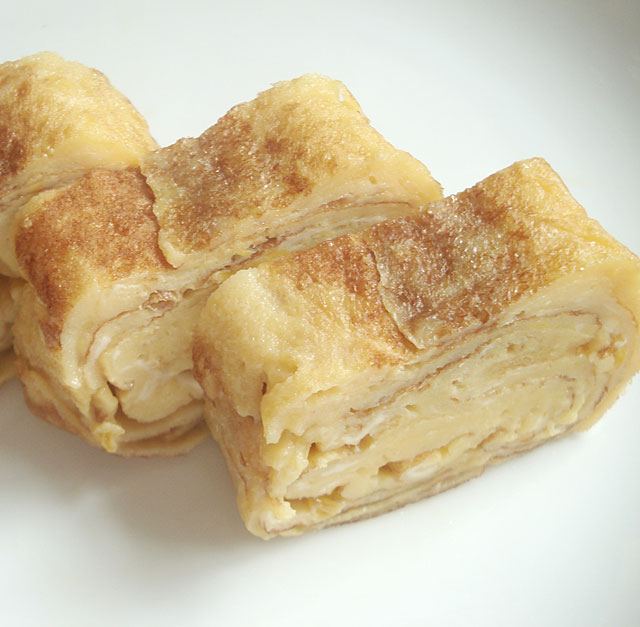
Tamagoyaki is such a integral part of Japanese food that I am rather kicking myself for not having posted a recipe for it before here. The name tamagoyaki means "fried egg", and the alternate name, atsuyaki tamago, means "thick fried egg". (Some books or restaurants erroneously called it just tamago, which just means "egg".) A slightly sweet, moist square-shaped egg concoction, tamagoyaki is a bento box staple, as well as being a popular sushi neta (topping). It's also great as a side dish for any meal.
Filed under:
basics eggs japanese bento washoku
 Yakitate!! Japan is a popular manga series. So popular in fact that it's one of the few manga that's available (legitimately) in English. There was also an anime series, which so far is only (legally) available in Japan. It sort of belongs to a genre of manga called Gourmet (gurume) Manga, manga whose main theme is food-related. The Wikipedia Japan page for Gourmet Manga lists more than 100 titles in this genre, though as far as I know only Yakitate!! is available in English at the moment. (I'll be talking about other gourmet manga eventually.)
Yakitate!! Japan is a popular manga series. So popular in fact that it's one of the few manga that's available (legitimately) in English. There was also an anime series, which so far is only (legally) available in Japan. It sort of belongs to a genre of manga called Gourmet (gurume) Manga, manga whose main theme is food-related. The Wikipedia Japan page for Gourmet Manga lists more than 100 titles in this genre, though as far as I know only Yakitate!! is available in English at the moment. (I'll be talking about other gourmet manga eventually.)
The Yakitate part of the title means "freshly baked". The Japan part is a pun of sorts: pan is the Japanese word for bread (the word was imported from Portuguese most likely), and the goal of the main character is to find the ultimate JaPan, or Japanese bread. The title sequence of the anime says that "There's furansu pan (French bread), igirisu pan (English bread), doitsu pan (German bread) but no bread to represent Japan". The story unfolds in the form of several big Iron Chef style baking competitions, where the main character Kazuma Azuma and others vie with each other for fame and glory. A running gag is that the bread creations are so delicious that they make the eaters, especially main judge Kuroyanagi, have extreme reactions like dying and going to heaven, or (from another judge) sprouting a live peacock out of his head.
Filed under:
books and media bread japanese manga
Pages